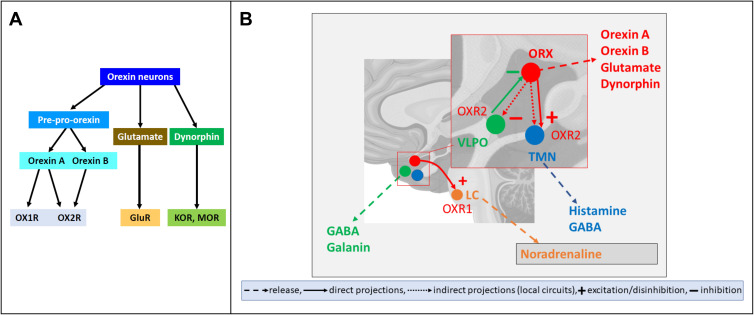Figure 1.
Neurochemistry and neuroanatomy of orexin neuron signaling. (A) summarizes the neurochemistry of orexin neuron signaling. Orexin neurons synthetize pre-pro-orexin, which is cleaved into the orexin (A and B) peptides (OXA and OXB, respectively). Orexin A acts by binding both orexin receptor 1 and (OXR1 and OXR2, respectively), whereas orexin B binds with high potency only OXR2. Orexin neurons may co-release glutamate, which binds its receptors (GluR), and dynorphin, which binds kappa opioid receptors (KOR) and mu opioid receptors (MOR). (B) illustrates three of the main projections of orexin neurons that are of particular relevance to wake-sleep control. Orexin (ORX) neurons indirectly inhibit neurons of the ventrolateral preoptic nucleus (VLPO) of the hypothalamus, which promote sleep, express gamma-aminobutyric acid (GABA) and galanin, and inhibit ORX neurons. In addition, ORX neurons directly excite and indirectly disinhibit neurons of the hypothalamic tuberomammillary nucleus (TMN), which co-release histamine and GABA to promote wakefulness. Finally, ORX neurons excite neurons of the locus coeruleus in the pons, which release noradrenaline and promote wakefulness. The effects of ORX neurons on the VLPO and TMN are mainly mediated by OX2R, whereas those on the LC are mainly mediated by OX1R. Other projections of ORX neurons as well as of VLPO, TMN, and LC neurons were omitted for clarity.

